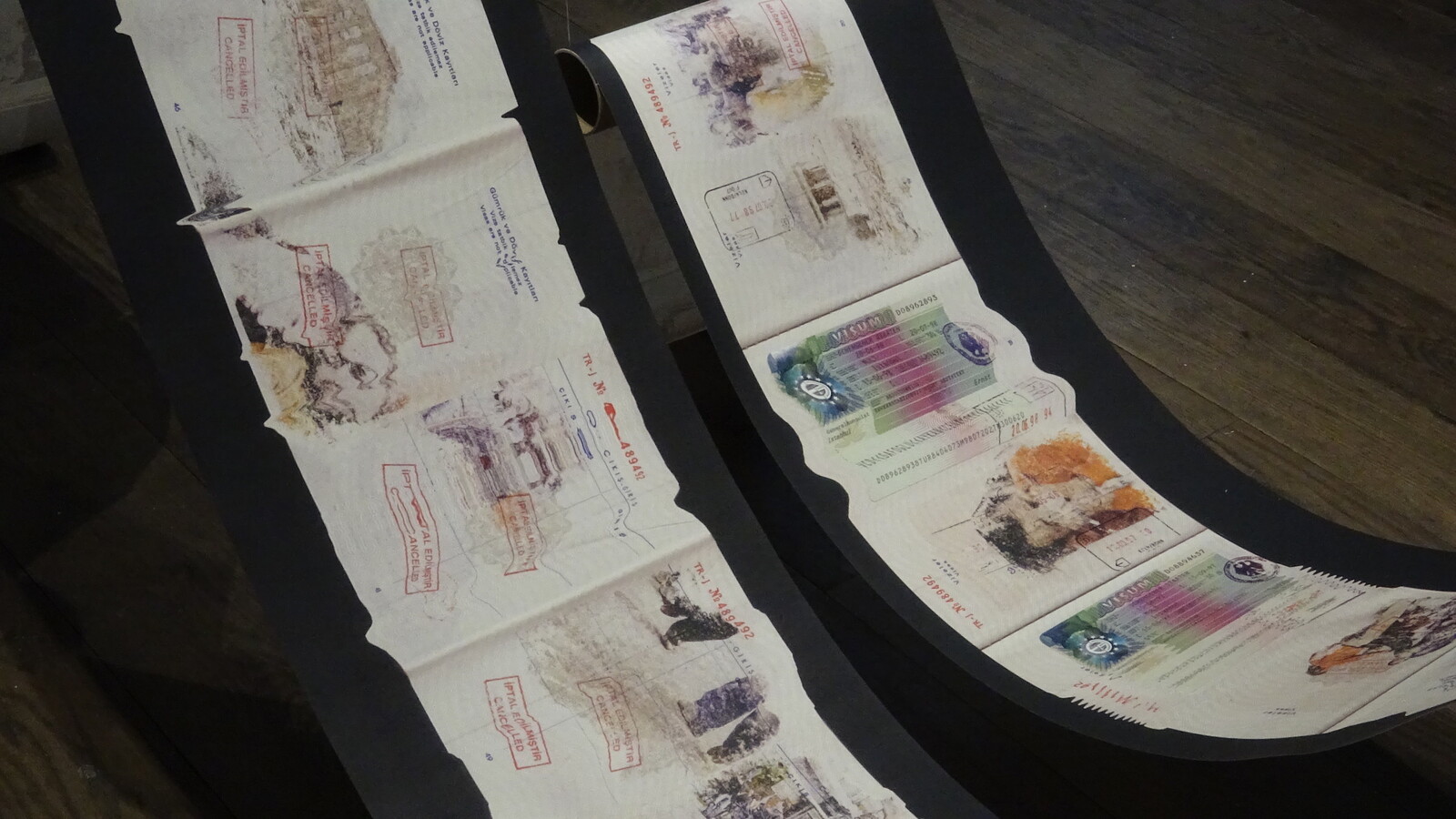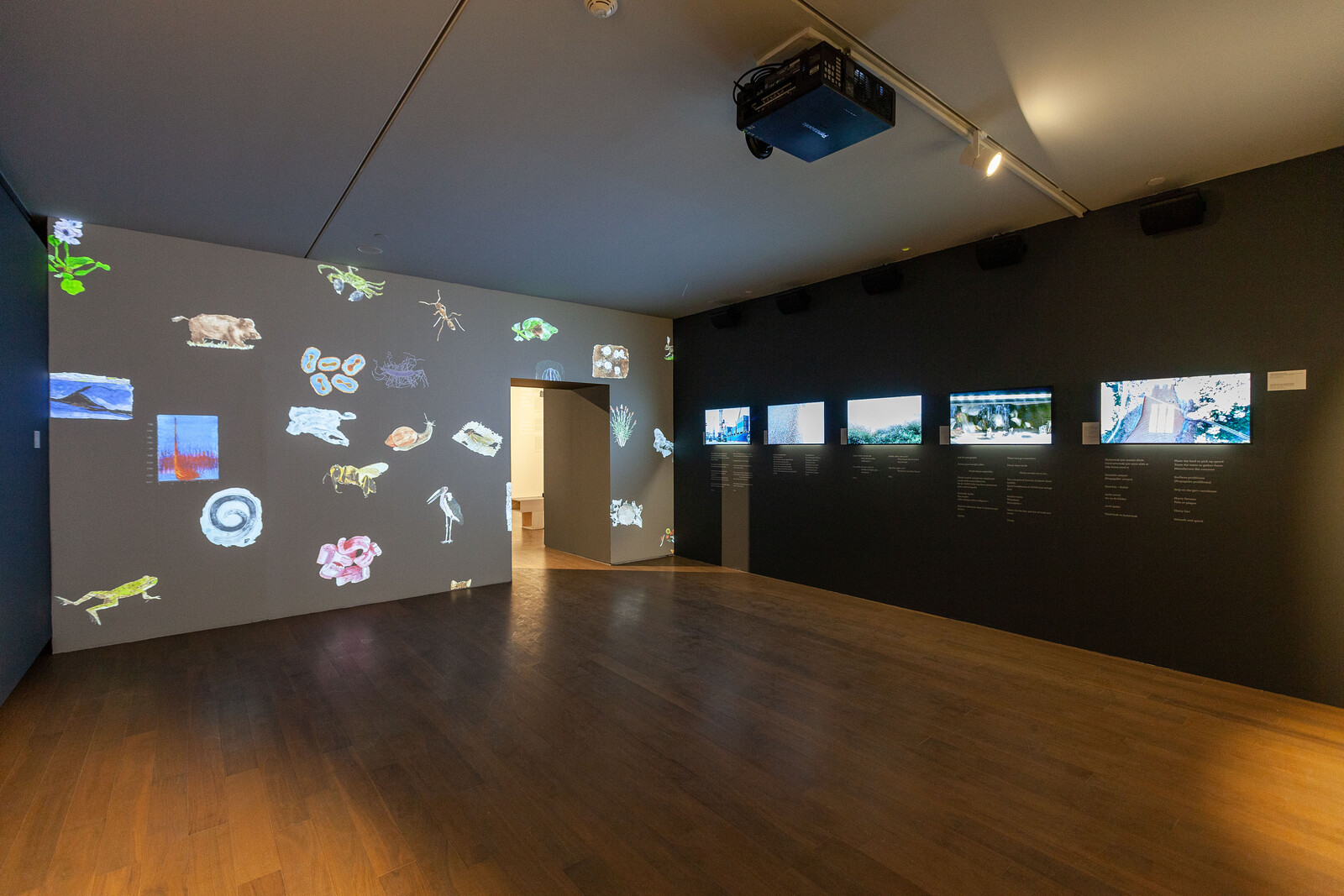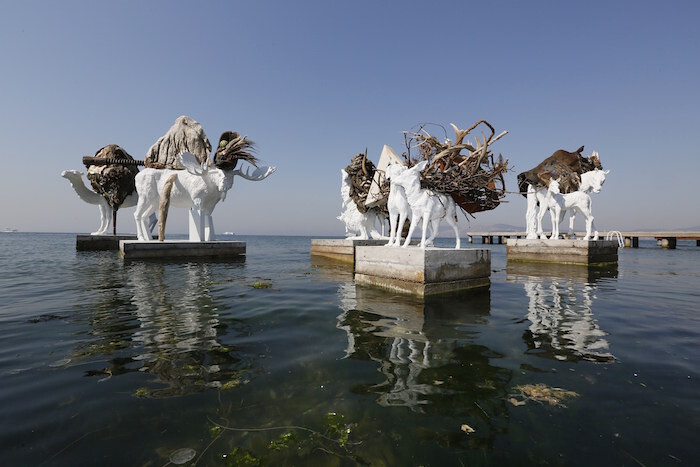Categories
Subjects
Authors
Artists
Venues
Locations
Calendar
Filter
Done
December 11, 2020 – Review
Aykan Safoğlu’s “Revolving Dreams”
Ulya Soley

How do personal memories become fragments of a political narrative? How can images guide us back through the past? A double-exposed print-out of private and political histories, Aykan Safoğlu’s installation Revolving Dreams (Athens/Istanbul, May 4-7, 2006) (all works 2020) features a series of images suspended from invisible threads. Pages from the artist’s old passport, superimposed with photographs from his personal archive, are enlarged and printed on two long scrolls which hang from the ceiling like waves. The work takes its cue from the bus journey Safoğlu (who was born in Turkey and now lives in Berlin) made from Istanbul to Athens in 2006, along with two friends and a group of alter-globalization activists, to participate in the fourth European Social Forum. The event—which marked the artist’s first encounter with discussions around immigration and climate crisis—brought together activists, NGOs, refugees, and environmental and anti-racist movements. Safoğlu revisits photographs taken over those few days in order to contemplate what the participants would transmit to a contemporary audience, for whom these issues have only gained in urgency.
The work invites us to consider the political shifts in both Turkey and Greece since 2006: the Justice and Development Party (AKP) had only recently come …
September 16, 2019 – Review
16th Istanbul Biennial, “The Seventh Continent”
Murat Alat

A psychiatrist friend once told me that most psychotic patients believe that they will see the apocalypse. If this argument is valid, nowadays either everyone is psychotic or the end of the world is really nigh. As a pessimist, I think both are possible.
The 16th iteration of the Istanbul Biennial, “The Seventh Continent,” is an exhibition about this deadlock. By considering the rise of fascism, misogyny, and the environmental crisis as indicators of this process, the exhibition displays the tragic results of human hubris but does not stop at this point. It creates new experiences and encounters to overcome the existing crisis. This biennial is not only an attempt to criticize society but also an attempt to establish new forms of being.
“The Seventh Continent” takes its name from the Great Pacific garbage patch—a gyre of mostly plastic debris, roughly 3.4 million square kilometers large, adrift in the Pacific Ocean. Curator Nicolas Bourriaud describes the exhibition as an anthropological study of this human-made territory. But the titular continent is more than an artificial landscape. It is, he claims, a way of living, a system of thought that has reached every part of contemporary life and attests to the inverted …
September 7, 2015 – Review
“Saltwater: A Theory of Thought Forms”
Ana Teixeira Pinto

“Saltwater: A Theory of Thought Forms” takes its name and inspiration from the eponymous book Thought-Forms (1901) by the Theosophists Annie Besant and Charles Leadbeater, who, after the death of the prominent Theosophist Madame Blavatsky (1831–91), expanded and re-conceptualized her attempt to extrapolate Newton’s theory of color into a syncretic cosmology. According to Besant and Leadbeater, “thoughts are things,” and as such, they can manifest as visible auras. Thought-Forms is a detailed account of “what kind of thing a thought is,” in which Besant and Leadbeater document the “spiritual vibrations” which emanate from ideas, emotions, and sounds as visual shapes, colors, and forms. The book, whose illustrations are exhibited in what curator Carolyn Christov-Bakargiev calls “The Channel”—the nucleus of the exhibition, installed at Istanbul Modern, the biennial’s central venue, which plays a function akin to that of “The Brain” in Documenta 13—could be aptly described as a “a sort of spiritual synesthesia, as much a religious act as a neurological one.”
Materialization of psychic phenomena was a widespread obsession in late nineteenth-century occult circles. Around the 1870s, a plethora of psychics would claim to act as conduits or transmitters, which, much like a radio frequency receiver, could capture cosmic vibrations …
May 23, 2014 – Review
“Who Shall Deliver Us From the Greeks and Romans?”
Merve Ünsal

“Who Shall Deliver Us From the Greeks and Romans?”—an exhibition curated by Cristiana Perrella for Galeri Manâ—directly addresses a recent trend in contemporary art of looking back towards classical Greek and Roman visual culture for sources and inspiration. The presentation includes works from a range of artists from different backgrounds—such as Lisa Anne Auerbach and Aleksandra Mir; Steven Claydon; Özlem Günyol and Mustafa Kunt; Matthew Monahan; Jonathan Monk; and Liam Gillick—which oscillate between mimetic homages of the classical ideal and a more self-reflexive critique of Antiquity’s influence throughout the history of art. Each of the artists’ visual subversions of common classical objects are subtle, demonstrating the exhibition’s success in creating a critical distance to the Greek and Roman artistic legacy.
Upon entering Galeri Manâ’s lofty space—a converted wheat mill—one encounters Daniel Silver’s new series of untitled busts on pedestals. These works, which closely resemble their antique counterparts, affirming the exhibition’s point of departure, set the stage for a range of practices that stand in differing relation to the classical past. Hanging beside Silver’s sculptures are Francesco Vezzoli’s laser prints of “crying” busts on canvas, with titles like EMPEROR CALIGULA CRYING FRANCIS BACON’ FIGURES AT THE BASE OF A CRUXIFICATION (2014), which …
September 15, 2013 – Review
“Mom, Am I Barbarian?” 13th Istanbul Biennial
Elmas Deniz

Curator Fulya Erdemci has said that the focus of the 13th Istanbul Biennial, “Mom, Am I Barbarian?,” is “the notion of the public domain as a political forum.” The evocative title is borrowed from poet Lale Müldür’s eponymous book, with the obvious connotations of a sense of being an ultimate “Other,” one who cannot find a space to freely express him/herself in the above-mentioned public domain, in opposition to the classical notion of a “citizen,” imbued with various rights including the potential to be an actor in the public sphere. The problems of democratic public space, aggressive urban transformation, political engagement, collective living, and what role poetry and art might play in these realms are themes that the biennial orbits around. Given the events in Istanbul over the past few months, these would seem entirely promising and of-the-moment considerations. And yet this year’s biennial has charted its own retreat from Istanbul’s public space, and the contrast between this “within four walls” exhibition—showing eighty-eight international artists in five different venues—and what is going on outside is cacophonous.
As is by now well-known, in mid-May something quite unexpected happened in Turkey: the Gezi Resistance began. It started out as a protest by a …
June 25, 2013 – Review
Sarkis’s “İkiz/Twin”
Merve Ünsal

In Karaköy, Istanbul, down the hill from the ongoing peaceful protests near Taksim Square, Galeri Manâ has been open only intermittently for the last three weeks. Yet the elegant exhibition on view there since late May serves as a moment of silence (contrasted to the immediate surroundings) and as a tribute to the influential practice of Sarkis, the Paris-based artist (born in 1938), who goes by his first name. Merging architectural, historical, and artistic references with his personalized vocabulary of materials and gestures, his works resonate with urgency in light of the recent protests that have woken the city from its slumber. In the exhibition, there’s a video playing on a screen supine on the floor. It depicts the artist dripping candlewax into his palm, the corporeal coyly mingled with the spiritual here, reframing the gesture of opening up one’s palm with that of physical pain.
The context of the gallery is important: Sarkis employs the entirety of the former mill’s two floors, and his choice material is copper, whose reflective, warm, shiny surfaces are giving, inclusive, preventing the story from unraveling in a linear manner. Some works are even easy to miss: the copper chains, hanging from the ceiling to …
March 22, 2013 – Review
Aslı Çavuşoğlu’s “Murder in Three Acts”
Merve Ünsal

Outside it’s like any other apartment building; inside hides a cinema. NON, located in a grand building on the bustling Istiklal Avenue, has been transformed into a multiplex cinema with three delectable episodes of Aslı Çavuşoğlu’s Murder in Three Acts (2012–2013) on view. Murder, yes, “crime scene investigations” (CSI), yes, and, hold on to your seat, art objects. Here is where the detective work begins. These objects are displayed in a room with burgundy walls, evoking musty exhibitions of Old Masters. One can see the velvet, feel it, even though it is not there. The silence of an auction house preview room and the dramatic lighting in the context of the apartment-gallery contribute to the absurdly formal situation. These objects, after all, are only meaningful within the context of the crime.
But what is that crime? We are left to guess. Five traditional coffee tables, each pierced with a vertical block of marble, are scattered throughout the room. The flawless obsidians are fetishized in the mechanisms of dignified display, perfectly placed, instilling a sense of preciousness. But the objects are too banal, and one gets the uncanny feeling that Çavuşoğlu is dismantling rather than upholding these traditional methodologies of display.
Into the …
November 8, 2012 – Review
Füsun Onur’s “Variations” at Maçka Sanat Galerisi, Istanbul
Merve Ünsal

Füsun Onur (born 1938) is an artist whose practice is defined by the persistent use of modest materials. While her work recently met with a greater audience this summer at Documenta 13, in the local Istanbul context she has been showing with Maçka Sanat Galerisi since 1987. Her fifth solo show there remained on a characteristically modest scale.
A slightly below ground level storefront, Maçka Sanat Galerisi is covered wall-to-wall in light brown-yellow tiles, from the steps leading to the entrance of the gallery into the gallery itself. Onur has employed the unusual space as both a catalyst and central element for “Variations,” with the muted lighting acting as a subtle deviation from the very particular architecture. The installation in the front room, at first glance, is almost invisible. From a distance, the tiled wall seems to be speckled with colorful dots, but upon closer inspection, the work is revealed as barely but fully three-dimensional. Each tile is covered in sheer plastic that is peeling off on one edge, weighted down by colorful paper clips. Here we find a subtle threat of being dismantled—the fragility of the materials in clear contrast to the flawless yet weathered unity of the tiles, suggesting …
January 11, 2012 – Review
Douglas Gordon’s “Phantom”
Merve Ünsal

Upon entering Galeri Manâ’s large doors, the viewer is greeted by almost complete darkness. A wooden stage is setup with a projection screen diagonally dividing it into two. On the side closer to the door are the remains of a burnt piano and a new Steinway, glaringly juxtaposed. A heavily made-up eye appears on the white background of the projection screen as Rufus Wainwright’s voice and music fill up the space.
Douglas Gordon’s first exhibition in Turkey, “Phantom,” hits its first notes on a self-conscious stage, the namesake work. The different elements of the installation (sound, objects, lighting, visuals) slowly unfold for the patient viewer. Gordon’s collaboration with Rufus Wainwright is elegantly simple—the eye that appears on the screen is Wainwright’s and bears witness to Wainwright’s album, All Days Are Night: Songs for Lulu, partly written in response to his mother’s death in 2010. The make-up is a nod to the hyper-awareness of publicly processing grief, loss, and memory. The highly aestheticized eye not only takes in the music and the situation, but also the viewer pacing the space, entranced by the beautiful and the lost, the personal and the public, the theatrical and the intimate.
The works in the upstairs gallery …
November 16, 2011 – Review
Annika Eriksson’s "An exhibition by Annika Eriksson"
Basak Senova

It is no coincidence that NON chose the Swedish artist Annika Eriksson to open up their new gallery space, located in a historical building (the renowned Misir Apartments) on Istiklal, the most crowded and renowned avenue of Istanbul. Previously located in the Tophane district, the gallery was subject last year to an organized attack by a mob armed with batons, bottles, and pepper spray during an opening—an attack which didn’t escape the other three galleries in the neighbourhood. The violence was initially considered merely a reaction to the gentrification process and significant increase in real estate prices, with the emergence of art galleries in that poor and religiously conservative district. The incident not only brought various contradictory political, economic, and cultural issues to the fore, but also revealed the gaping divide between the contemporary art scene and the greater public. Ironically, unlike the other galleries, NON prides itself on working with artists and curators with sharp political and ideological views, and, furthermore, the gallery takes special interest in social issues. In this respect, Eriksson’s work, which is mostly based on social investigations and urban situations, creates a basis for further discussions on the alternating relationship between the public and the …
September 20, 2011 – Review
"Untitled (12th Istanbul Biennial)"
Chris Sharp

Unlike most biennials, this is not so much an exhibition about what art can be, but about what it is. If there is anything radical about this exhibition, it is its refusal to conform to those biennial conventions that have come to characterize this particular exhibition format of the last decade: site or context-specific interventions or experimental projects of an overtly politically engaged nature, which often do not hesitate to subordinate formal or aesthetic considerations to political ones—including the dismissal of other conventions, such as the refusal to release the artist list before the opening and an avowed allergy to discursive biennial apparatuses—talks, panels, etc.—in favor of a straight exhibition. In other words, this is a formal biennial.
This formalism bears out in the two curators’ decision to use the work of Felix Gonzalez-Torres as their conceptual point of departure. Confining the exhibition to a single, museum-like, two-venue site, Jens Hoffmann and Adriano Pedrosa have concisely structured the biennial around five Gonzalez-Torres works— Untitled (Bloodwork—Steady Decline), 1994; Untitled (Ross), 1991; Untitled (Passport #II), 1993; Untitled (History), 1998; and Untitled (Death by Gun), 1990—from which they have distilled five themes. These themes, in turn, are used as jumping off points for considering …
Load more